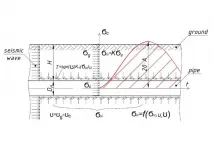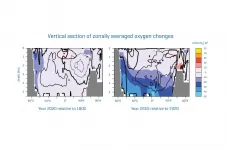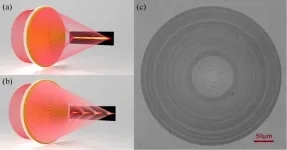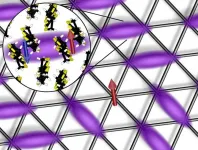Thermoelectric material discovery sets stage for new forms of electric power in the future
Clemson physicist joins forces with collaborators from China and Denmark to create hybrid compound
2021-04-16
(Press-News.org) Thermoelectrics directly convert heat into electricity and power a wide array of items -- from NASA's Perseverance rover currently exploring Mars to travel coolers that chill beverages.
A Clemson University physicist has joined forces with collaborators from China and Denmark to create a new and potentially paradigm-shifting high-performance thermoelectric compound.
A material's atomic structure, which is how atoms arrange themselves in space and time, determines its properties. Typically, solids are crystalline or amorphous. In crystals, atoms are in an orderly and symmetrical pattern. Amorphous materials have randomly distributed atoms.
Clemson researcher Jian He and the international team created a new hybrid compound in which the crystalline and amorphous sublattices are intertwined into a one-of-a-kind crystal-amorphic duality.
"Our material is a unique hybrid atomic structure with half being crystalline and half amorphous," said He, an associate professor in the College of Science's Department of Physics and Astronomy. "If you have a unique or peculiar atomic structure, you would expect to see very unusual properties because properties follow structure."
The high-profile energy research journal Joule published their findings in a paper titled "Thermoelectric materials with crystal-amorphicity duality induced by large atomic size mismatch," which appeared online on April 16 ahead of the May 19 issue.
The researchers created their hybrid material by intentionally mixing elements in the same group on the periodic table but with different atomic sizes. Here, they used the atomic size mismatches between sulfur and tellurium and between copper and silver to create a new compound (Cu1-xAgx)2(Te1-ySy) in which the crystalline and amorphous sublattices intertwine into a one-of-a-kind crystal-amorphicity duality. The new compound exhibited excellent thermoelectric performance.
While this discovery doesn't directly impact application now, it is likely to lead to better thermoelectrics in the future.
"The new material performs well, but more important than that is how it achieves that level of performance," He said. "Traditionally, thermoelectric materials are crystals. Our material is not pure crystal, and we show we can achieve the same level of performance with a material with a new atomic structure."
He said he expects the new material will begin affecting applications in 10 to 20 years.
"They definitely can do something current thermoelectric materials cannot do, but not now," He said. "However, the future of this research is bright."
In addition to He, the research involved scientists from Shanghai Jiaotong University, Shanghai Institute of Ceramics and SUSTech in China, and Aarhus University in Denmark.
INFORMATION:
The Clemson University College of Science pursues excellence in scientific discovery, learning and engagement that is both locally relevant and globally impactful. The life, physical and mathematical sciences converge to tackle some of tomorrow's scientific challenges, and our faculty are preparing the next generation of leading scientists. The College of Science offers high-impact transformational experiences such as research, internships and study abroad to help prepare our graduates for top industries, graduate programs and health professions. clemson.edu/science
[Attachments] See images for this press release:
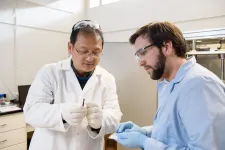
ELSE PRESS RELEASES FROM THIS DATE:
2021-04-16
Russian scientists have proposed a theory of phase transformation in polymer gels. It explains the mechanisms of the dramatic reduction in volume of zwitterionic hydrogels when they are cooled. The results are published in the journal Chemical Communications (ChemComm).
Polymer gels have unusual properties, including the ability to absorb water in volumes hundreds of times greater than their own. For example, some hydrogels are capable of holding up to two kilograms of water per gram of dry gel. By changing the temperature or adding solvents, various desired properties can be achieved. This is why polymer gels are used in industry and biomedicine, including for the targeted delivery of medication, creation of artificial skin, children's toys, etc.
If you take ...
2021-04-16
Two new studies published in Blood suggest that the mRNA COVID-19 vaccine may have reduced efficacy in individuals with chronic lymphocytic leukemia (CLL) and multiple myeloma, two types of blood cancer. According to researchers, these studies could help inform the ideal time for vaccination of these populations.
Study suggests two-dose COVID-19 vaccine is less effective for people with CLL as compared to healthy controls
The first study reports that people with CLL had markedly lower immune response rates to the two-dose mRNA COVID-19 vaccine than healthy individuals ...
2021-04-16
Underground pipelines that transport oil and gas are very important engineering communications worldwide. Some of these underground communications are built and operated in earthquake-prone areas.
Seismic safety or seismic stability of underground pipelines began to be intensively studied since the 1950s.
Since then, a number of methodologies were proposed for calculating stress received by an underground pipeline during an earthquake. The purpose of these methodologies was to make an accurate prediction on the structural stress received by a pipeline during an earthquake, and thus it would allow to decide ...
2021-04-16
A virtual human can be as good as a flesh-and-blood one when it comes to helping people practice new leadership skills. That's the conclusion from new research published in the journal Frontiers in Virtual Reality that evaluated the effectiveness of computer-generated characters in a training scenario compared to real human role-players in a conventional setting.
Practice-based training techniques, including role-playing, are sometimes used to help improve training outcomes. However, these methods can be expensive to implement, and often require specialized knowledge and even professional actors to create realistic training environments. In addition, some ...
2021-04-16
The preliminary trial results of a novel radiopharmaceutical for PET imaging of inflammation developed at the University of Turku, Finland, have been published. The compound, which targets the vascular adhesion protein 1 (VAP-1) that regulates inflammatory cell traffic, is the first radiopharmaceutical that has been developed completely in Finland and has advanced to clinical trials. In the study that started with healthy volunteers, the radiopharmaceutical was found to be well tolerated and safe.
The radiopharmaceutical is 68Ga-labelled Siglec-9 peptide.
"The dose of the radiopharmaceutical ...
2021-04-16
"It is machination, it is deception," said the Director General of the Berlin Royal Museums in his defence when criticized for buying a fake. Wilhelm Bode did not budge an inch: the sculpture he acquired in 1909 was an as yet unknown production of the great Renaissance master, Leonardo da Vinci. After one hundred years and numerous controversies, a group of scientists led by a CNRS researcher* has just proven him wrong once and for all. The Flora wax bust, conserved at the Bode Museum in Berlin, recently underwent radiocarbon (14C) dating, which provided both a precise date and an incontrovertible result: it was made in the nineteenth century, nearly 300 years after da Vinci's death. As the sculpture was made primarily from spermaceti, ...
2021-04-16
The life of almost all animals in the ocean depends on the availability of oxygen, which is dissolved as a gas in seawater. However, the ocean has been continuously losing oxygen for several decades. In the last 50 years, the loss of oxygen accumulates globally to about 2% of the total inventory (regionally sometimes significantly more). The main reason for this is global warming, which leads to a decrease in the solubility of gases and thus also of oxygen, as well as to a slowdown in the ocean circulation and vertical mixing. A new study published today in the scientific journal Nature Communications ...
2021-04-16
In a new publication from Opto-Electronic Advances; DOI https://doi.org/10.29026/oea.2021.200031, Researchers led by Professor Baohua Jia at Swinburne University of Technology, Victoria, Australia, Professor Cheng-Wei Qiu at National University of Singapore, Singapore and Professor Tian Lan at Beijing Institute of Technology, Beijing, China considered the generation of super-resolved optical needle and multifocal array using graphene oxide metalenses.
Ultrathin and lightweight, metalenses are becoming increasingly significant for their use in photonic chips, biosensors and micro imaging systems such as smart phone cameras.
Compared to conventional lenses, metalenses can improve the image quality of current cameras, ...
2021-04-16
In most living animals, egg cells are vastly larger than sperm cells. In humans, for example, a single egg is 10 million times the volume of a sperm cell.
In a new study, Northwestern University researchers found that competition and natural selection drove this curious size discrepancy.
Using mathematical modeling, the researchers considered a time very early in evolution when primordial species reproduced using external fertilization. In the model, bigger reproductive cells, or gametes, presented a competitive edge because they could hold more nutrients for a potential zygote. Smaller gametes, however, required fewer resources to make, which put less stress on the parent.
"Organisms either needed to produce the biggest gametes with the most provisions ...
2021-04-16
When temperatures drop below zero degrees Celsius, water turns to ice. But does everything actually freeze if you just cool it down enough? In the classical picture, matter inherently becomes solid at low temperatures. Quantum mechanics can, however, break this rule. Therefore, helium gas, for example, can become liquid at -270 degrees, but never solid under atmospheric pressure: There is no helium ice.
The same is true for the magnetic properties of materials: at sufficiently low temperatures, the magnetic moments known as 'spins', for example, arrange themselves in such a way that they are oriented opposite/antiparallel to their respective neighbors. One can think of this as arrows pointing alternating up and down along a chain or in a checkerboard pattern. It ...
LAST 30 PRESS RELEASES:
[Press-News.org] Thermoelectric material discovery sets stage for new forms of electric power in the future
Clemson physicist joins forces with collaborators from China and Denmark to create hybrid compound

